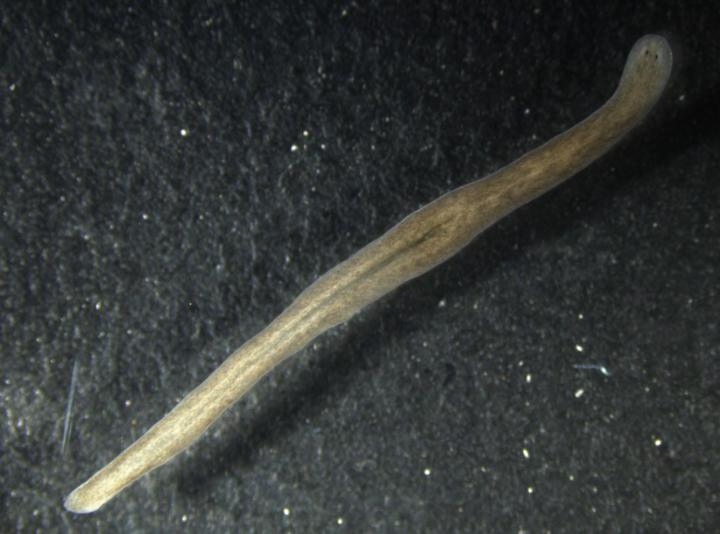Findings in worm with regenerative prowess could aid human tissue engineering methods

Credit: Northwestern University
The planarian flatworm is a simple animal with a mighty and highly unusual ability: it can regenerate itself from nearly every imaginable injury, including decapitation. These tiny worms can regrow any missing cell or tissue — muscle, neurons, epidermis, eyes, even a new brain.
Since the late 1800s, scientists have studied these worms to better understand fundamental principles of natural regeneration and repair, information that could provide insights into tissue healing and cancer. One mechanism that is yet unknown is how organisms like these control the proportional scaling of tissue during regeneration.
Now, two Northwestern University molecular biologists have identified the beginnings of a genetic signaling pathway that puts the brakes on the animal’s growth. This important process ensures the appropriate amount of tissue growth in these highly regenerative animals.
“These worms have essentially discovered a natural form of regenerative medicine through their evolution,” said Christian Petersen, who led the research. “Planarians can regenerate their whole lives, but how do they limit their growth? Our discovery will improve understanding of the molecular components and organizing principles that govern perfect tissue restoration.”
The findings ultimately may have important ramifications for novel tissue engineering methods or strategies to promote natural repair mechanisms in humans.
Petersen is an associate professor of molecular biosciences in Northwestern’s Weinberg College of Arts and Sciences. He and Erik G. Schad, a graduate student in Petersen’s lab, conducted the study.
The results were published in the Jan. 20 issue of the journal Current Biology. Petersen is the corresponding author, and Schad is the paper’s first author.
The researchers have identified a control system for limiting regeneration and also a new mechanism to explain how stem cells can influence growth. Specifically, Petersen and Schad discovered that a gene called mob4 suppresses tissue growth in the animals. When the researchers inhibited the gene in experiments, the animal grew to twice its normal size.
The gene, they found, works in a rather surprising way: by preventing the descendants of stem cells from producing a growth factor called Wnt, a protein released from cells to communicate across distances. The Wnt signaling pathway is known to play a role in cancer cell regeneration.
Planarians are 2 to 20 millimeters in size and have a complex anatomy with around a million cells. They live in freshwater ponds and streams around the world. The worm’s genome has been sequenced, and its basic biology is well-characterized, making planarians popular with scientists.
###
Petersen also is a member of the Robert H. Lurie Comprehensive Cancer Center of Northwestern University.
The title of the paper is “STRIPAK Limits Stem Cell Differentiation of a WNT Signaling Center to Control Planarian Axis Scaling.”
Media Contact
Megan Fellman
[email protected]
847-491-3115
Related Journal Article
http://dx.




